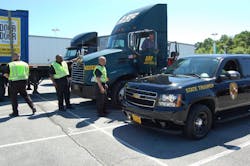Preparing for annual effort to boost brake safety
I’ve talked to Steve Keppler (seen at right), CVSA’s executive director, about this yearly campaign numerous times and he still strongly believes such a targeted inspection effort is a necessity.
“Properly functioning brake systems are crucial to safe vehicle operation and improperly installed or poorly maintained brakes must be kept off the road,” he explained in a statement this week. “This intensive, unified enforcement effort brings about a greater awareness throughout the industry and that saves lives.”
Yet Keppler is well aware of the challenges facing efforts to boost better care and maintenance of truck brake systems within trucking in this space a few years back as to really drive significant decreases in brake out of service (OOS) rates – and OOS rates overall in the trucking business – will require a more integral shift in the industry’s “safety culture,” which will take time, he told me.
“It’s doubly difficult to get such a change to stick because the [profit] margins in this industry are just so thin,” Keppler pointed out. “There’s also reluctance to change because change breeds uncertainty. But the steady decrease in component OOS rates gives me confidence that the industry is making this ‘safety culture’ adjustment.”
Brakes also remain by far one of the most critical components of ongoing efforts to improve truck safety overall. For example, take a look at the video below of a Volvo FH tractor testing the OEM’s new “emergency braking system.” That technology simply would never work if the truck’s brakes malfunction even the tiniest bit.
CVSA’s Keppler also noted that inspections conducted during “Brake Safety Week” consist primarily of the brake-specific Level IV special study type, though some Level I inspections are also conducted. He added that carriers are encouraged to be involved by helping educate drivers and mechanics about the importance of pre-trip inspections and proper brake maintenance.
To that end, Bendix Commercial Vehicle Systems LLC recently put together a couple of important tips to help fleets and driver’s alike better prepare for the six items that are flagged for inspection during CVSA’s brake safety enforcement campaign: driver’s license, registration, low air warning device, pushrod travel (more commonly referred to as being in or out of “adjustment”), brake linings/drums, leaks/air loss rate, and tractor protection system.
[Bendix also put together a good video about one of its “Tech Talks” covering the adjustment criteria for drum brakes.]
In addition to emphasizing regularly scheduled preventive maintenance and pre-trip inspections, Bendix stressed the importance of proper replacement components, air system management, and ongoing technician and driver education.
Replacement Friction Matters: When regular maintenance or pre-trip inspections point to a need for friction replacement, it’s important to recognize the impact that friction selection has on safety and brake performance, noted Gary Ganaway, director of marketing and global customer solutions for Bendix Spicer Foundation Brake LLC.
“With the federal reduced stopping distance (RSD) mandate now in full effect, fleets need to pay close attention to the issue of replacement brake lining performance and RSD compliance,” he said. “Because not all replacement friction marketed as acceptable under RSD will actually perform to the standard, fleets should ask for evidence of compliance from their friction supplier when replacing the friction on their RSD-equipped trucks.”To support this point, Bendix compared the stopping distance performance of various linings on high performance drum brakes. The company measured the 60 mph stopping distance of a mandate-compliant vehicle with OEM brakes and high performance linings. Bendix then replaced the friction with multiple non-high performance original equipment and aftermarket materials that had passed the FMVSS 121 dyno test, but were not suitable for mandate compliance.
With nothing else changed, the vehicle’s stopping distance increased from 215 feet using the high performance friction to 311 feet with the worst-performing aftermarket replacement friction – a 45% decrease in performance, according to component maker. That 96-foot difference in stopping distance – a total of five passenger car lengths – is a stark illustration of roadway safety at stake, Ganaway stressed.
The RSD mandate requires most trucks to stop within 250 feet. Phase one of the mandate took effect in August 2011 for new three-axle tractors with Gross Vehicle Weight Ratings (GVWRs) up to 59,600 lbs. Phase two, aimed at tractors with two axles, as well as severe service tractors with GVWRs above 59,600 lbs, took effect Aug. 1 this year.
Keeping the Air Clean: Protecting a vehicle’s air system from contamination is crucial for maintaining a safe and effective air brake system, Bendix said. Oil, in particular, can be very harmful to an air system, contributing to premature damage in a variety of components such as spring brake modulating valves and brake chamber diaphragms. And oil-deteriorated seals can cause air system leaks – a target of "Brake Safety Week," which is also known as "Operation Air Brake."
The installation and regularly scheduled replacement of air dryer cartridges can help ensure a brake system’s longevity and performance by collecting and removing solid, liquid, and aerosol contaminants before they enter the system, noted Fred Andersky, Bendix’s director of government and industry affairs.
“Adhering to a strict preventive maintenance schedule is key to keeping the air brake system clean and operating safely,” he said. “Air dryer cartridge replacement schedules vary according to the air compressor, operating environment, and vehicle usage, but fleets and drivers should check the functionality of their filters with monthly checks for moisture in the air brake system. If moisture is present, the air dryer cartridge may require replacement.”
Along with the air dryer cartridge, other components of the air dryer, including the purge valve assembly and the delivery check valve, should be inspected and replaced, Andersky added.
Good stuff to remember as "Brake Safety Week" gets rolling.


